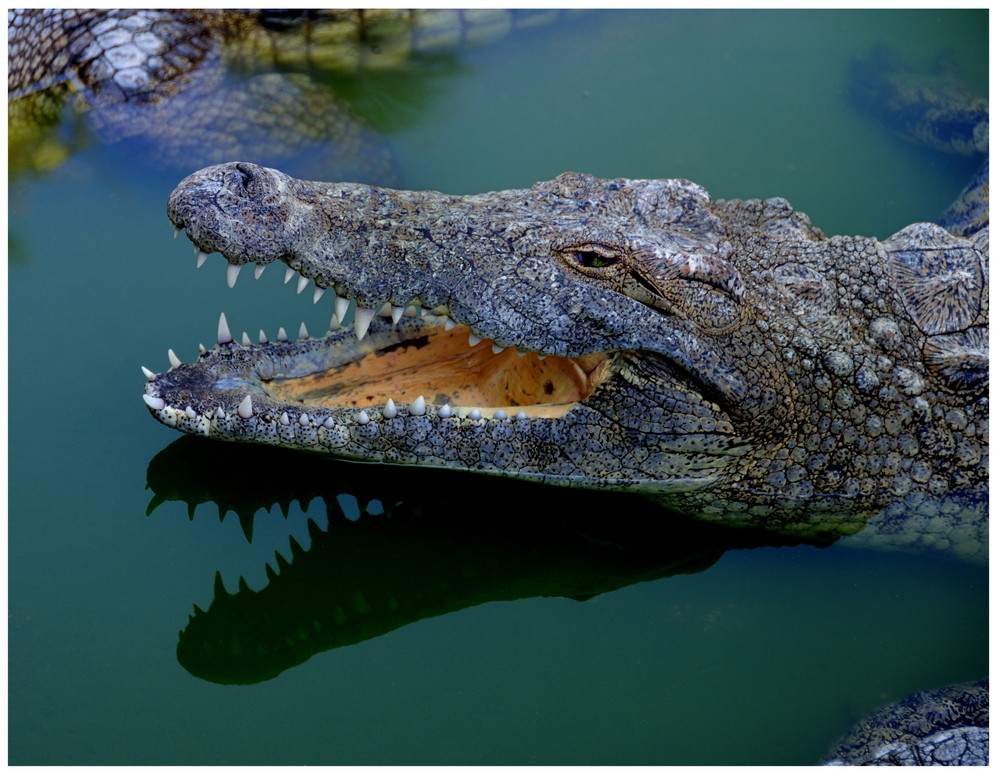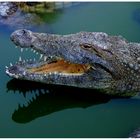bright eyes...
Crocodile Park Torremolinos

a green oasis....
Hans-Reiner Bohn
The Nile crocodile has a somewhat deserved reputation as a vicious man-eater. The proximity of much of its habitat to people means run-ins are frequent. And its virtually indiscriminate diet means a villager washing clothes by a riverbank might look just as tasty as a migrating wildebeest. Firm numbers are sketchy, but estimates are that up to 200 people may die each year in the jaws of a Nile croc.
Africa's largest crocodilian, these primordial brutes reach a maximum size of about 20 feet (6 meters) and can weigh up to 1,650 pounds (730 kilograms). Average sizes, though, are more in the range of 16 feet (5 meters) and 500 pounds (225 kilograms). They live throughout sub-Saharan Africa, the Nile Basin, and Madagascar in rivers, freshwater marshes, and mangrove swamps.
The diet of the Nile crocodile is mainly fish, but it will attack almost anything unfortunate enough to cross its path, including zebras, small hippos, porcupines, birds, and other crocodiles. It will also scavenge carrion, and can eat up to half its body weight at a feeding.
One unusual characteristic of this fearsome predator is its caring nature as a parent. Where most reptiles lay their eggs and move on, mother and father Nile crocs ferociously guard their nests until the eggs hatch, and they will often roll the eggs gently in their mouths to help hatching babies emerge.
Hunted close to extinction in the 1940s through the 1960s, local and international protections have helped them rebound in most areas. In some regions, though, pollution, hunting, and habitat loss have severely depleted their numbers.
(source: animals.nationalgeographic.com/animals/reptiles/nile-crocodile)










Hans-Reiner Bohn 12/10/2009 10:00
@Margarete: blau?Margarete Hartert 11/10/2009 13:44
So blau??LG Margarete
Annick 11/10/2009 7:52
Une très belle prise, une mâchoire impressionnante.Amitiés
Annick
Anca Silvia B. 11/10/2009 7:44
wowwww....fantastisch...Respekt hoch 2..... ;)
lg anca
Inge Stüwe 10/10/2009 8:30
Eine faszinierende Aufnahme, KOMPLIMENT!Liebe Grüße
Inge
Hanne L. 09/10/2009 21:44
Die 'technischen' Daten der Tiere sind schon respekteinflößend. Eine spektakuläre Aufnahme!Liebe Grüße, Hanne
Azelio Magini 09/10/2009 20:38
fa un po' impressione ma è molto bella.Wolfgang Vahrenholt 09/10/2009 16:34
Hat doch ein Lächeln auf den Lippen...grins.Aber eine tolle Aufnahme mit der Spiegelung.
LG Wolfgang
Gasser Lisbeth 09/10/2009 16:09
Top Aufnahme in allen Bereichen !Sehr schöne Arbeit Hans-Reiner !
LG Lisbeth
Vera Laake 09/10/2009 14:06
Herrlich abgelichtet hastDu dieses schöne Urtier.
Lieben Gruß
VERA
Josef Schließmann 08/10/2009 12:04
Wow, ganz stark, gefällt mir super auch mit dem Schatten.LG Josef
Thoralf 08/10/2009 10:49
sauber portraetiert hast Du dieses gigantische Reptil, auch die Farben sich schoen stimmigLG Thoralf
Phönix 07/10/2009 18:33
furchterregend :) ... aber die Farben sind genial ... gefällt mir,lg
Hans-Reiner Bohn 07/10/2009 10:30
@ Otto Gradi:isses aber nicht!
Otto Gradi - Otto Hitzegrad 07/10/2009 10:26
Tolles Motiv, wird durch den Schatten unterstrichen.Sieht für mich ein wenig nach HDR aus?
-----------------------------------------------------------------------------------------------------------
(Bitte hier in meinem Profil auch die Verlinkungen, zu meinen Seiten - mit ganz anderen Fotos, in der FC mal anschauen, danke!).
Liebe Grüße
Otto,
Otto Hitzegrad,
Otto Hitzegrad(2) und
Otto Gradi